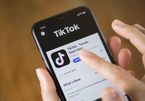TikTok doesn't share the same commitment as Facebook does about freedom of speech, he said, repeating this message in meetings with US students, legislators and the US President.
TikTok was banned by former US President Donald Trump in September 2020 after executive orders targeting Chinese technology companies were issued. ByteDance, the parent company of TikTok at that time, was on the verge of being torn apart by American tech giants. Microsoft and Oracle emerged as the potential buyers in the deal.
Finally, despite luck in escaping, ByteDance understood that it had fallen into the 'impregnable' land of Big Tech, because ByteDance's TikTok is holding a huge user data store of the generation that will control the world in the future, Gen Z.
The one who awakens giants
 |
|
|
ByteDance was founded by young engineer Zhang Yiming in 2012. At that time, the company was still struggling to find a way through the launch of many applications. Until Douyin was launched in China in late 2016, ByteDance had gained its first success with 100 million users after one year of operation.
Douyin's initial success helped ByteDance receive a huge amount of investment capital and Zhang Yiming then made a bold decision to enter the foreign market, something only Chinese tech giants like Tencent or Alibaba dare to think of doing.
And so then came TikTok when ByteDance spent $1 billion to acquire Musically, to immediately have 200 million foreign users. The rest is history.
After just four years, TikTok has 1.1 billion monthly active users (MAU) compared to 2.3 billion MAUs and 2.6 billion MAUs for YouTube and Facebook, respectively.
Numbers don't lie. Moreover, TikTok has created trends, social networking phenomena and attracted the majority of Gen Z users, or young people born in the late 90s and later.
Facebook or YouTube have set standards for social network design, and video length for other applications to imitate. But TikTok chose the opposite path.
It is not the first innovative platform, but TikTok knows how to create market demand and teach users. Young people today are often plugged into smartphones and have had very little time to monitor something. So TikTok has shortened the video length to just under 15 seconds.
TikTok forces users to either watch or skip, and not fast forward. Combined with recommended algorithms, the video matrix of TikTok makes it impossible for viewers to take their eyes off the short videos that are actually combined to be endlessly long.
If TikTok's format is not special, Instagram and YouTube wouldn't have to rush to launch an imitation. The giants sleeping in victory hastily woke up, but it may be too late as TikTok brought in $34.3 billion for ByteDance in 2020.
Although it has not been able to perform initial public offering (IPO) in the US due to pressure from Beijing, ByteDance is valued for not less than $300 billion, at least three times higher than that of Uber.
In Vietnam, TikTok used to spend a lot of advertising money to entice users and has gained about 10 million real users.
But few people know that, before TikTok appeared, there was a Vietnamese application that emerged in attracting young people called Muvik. This application also went in the direction of sharing music videos, focusing on lipsync tracks so that ordinary people can lip sync along with famous singers. However, focusing on only one genre, Muvik failed even when TikTok was not so popular in Vietnam.
After all, startups still need algorithms, tools, and artificial intelligence (AI) to analyze user behavior, suggest and recommend content before thinking about who and where the market is. Failing to do this, startups will only change from imitating Facebook to imitating TikTok.
Huu Phuong

Is Facebook fading in popularity?
A colleague of mine was surprised when his 17-year-old son, who is quiet on Facebook, is a "hot TikToker" with videos viewed by hundreds of thousands of people.